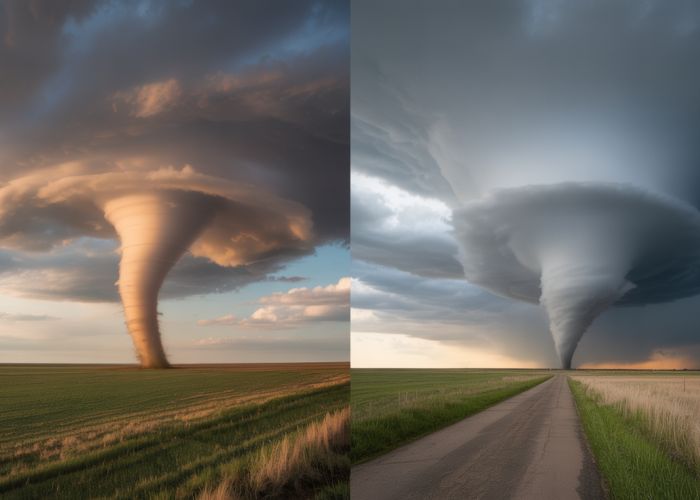The National Weather Service, a key entity in understanding severe weather, plays a crucial role in differentiating atmospheric phenomena. The common misconception surrounding tornado vs twister often leads to confusion, but understanding their nature is vital for risk assessment. This article clarifies these terms, leveraging insights into meteorological science to explain the shocking, and often misunderstood, differences between a tornado vs twister.

Tornado vs Twister: Unveiling the Real Differences
The terms "tornado" and "twister" are often used interchangeably, leading to confusion. However, understanding the true relationship between these words is key to properly comprehending these weather phenomena. This article aims to clarify the "tornado vs twister" debate, exploring the origins, scientific definitions, and common usage of each term.
Understanding the Terminology
The core issue surrounding "tornado vs twister" lies in semantics. Are they truly different meteorological events, or are they simply different names for the same thing?
Tornado: The Scientific Definition
A tornado is a violently rotating column of air extending from a thunderstorm to the ground. This definition is universally accepted by meteorologists and is the standard terminology used in scientific contexts. Key features that define a tornado include:
- Rotation: The air must be rotating in a vortex.
- Connection to a Thunderstorm: The vortex must originate from a parent thunderstorm, typically a supercell.
- Ground Contact: The rotating column of air must touch the ground to be officially classified as a tornado.
Twister: A Colloquial Term
"Twister" is a common, informal term used to describe a tornado. It is primarily used in everyday language and is not a scientific term recognized in meteorology. While widely understood, its lack of precise definition can sometimes lead to ambiguity.
Origin and Popular Usage
The prevalence of "twister" as a synonym for "tornado" is largely attributed to cultural influence.
Historical Context
The term "twister" likely originated from the visual description of a tornado’s swirling, twisting appearance. This descriptive nature made it an easily adopted term among the general public.
Media Influence
- Movies: The 1996 film Twister significantly popularized the term, cementing its association with tornadoes in the public consciousness.
- Literature: Popular literature frequently employs "twister" for dramatic effect, further contributing to its widespread use.
- News Reports: While scientific sources usually prefer "tornado," news reports sometimes use "twister" to appeal to a broader audience or to avoid repetition.
Comparing "Tornado" and "Twister": A Summary Table
The following table summarizes the key differences between "tornado" and "twister":
| Feature | Tornado | Twister |
|---|---|---|
| Definition | Scientific, precise | Colloquial, informal |
| Usage | Meteorology, scientific reports | Everyday language, media |
| Specificity | High, clearly defined phenomenon | Lower, general term for a rotating storm |
| Acceptance | Universally accepted within science | Widely understood but not scientifically defined |
| Geographic Bias | No specific geographic association | Perceived as more common in certain regions (e.g., Tornado Alley) |
Potential for Misinterpretation
While generally understood to mean the same thing, using "twister" can create slight ambiguities. For example, does it specifically refer to a strong tornado, or is it applicable to any rotating storm, including waterspouts? The scientific term "tornado" avoids these ambiguities.
Waterspouts: An Example of Ambiguity
Waterspouts are tornadoes that form over water. While technically tornadoes, some might argue that "twister" more aptly describes a particularly powerful waterspout, leading to potential confusion. The scientific clarity of "waterspout" (or "tornado over water") eliminates this issue.
Tornado vs Twister: Frequently Asked Questions
Here are some frequently asked questions to help clarify the difference between tornados and twisters. Hopefully, these will help you better understand these powerful weather phenomena.
Is "twister" just another name for a "tornado"?
Essentially, yes. "Twister" is a colloquial term, often used informally, to refer to a tornado. Scientifically speaking, meteorologists use the term "tornado." So, while both words describe the same dangerous weather event, "tornado" is the official and preferred term.
Why do people use the word "twister" then?
The term "twister" is more common in certain regions of the United States, particularly in the Midwest. It’s also a popular term in movies and popular culture. So, usage of "tornado vs twister" comes down to either a regional term or pop culture influence.
Are some tornados more likely to be called "twisters" than others?
Generally, no. The term "twister" isn’t typically used to differentiate between types of tornados. It’s simply a less formal way of referring to any tornado, regardless of its strength or size.
Should I be worried if I hear someone say "twister" instead of "tornado"?
Not necessarily more worried, but definitely concerned! Whether it’s called a "tornado" or a "twister," the danger is the same. Take any warnings seriously and follow safety precautions immediately. The name used, "tornado vs twister" doesn’t change the destructive potential.
So, there you have it! Hopefully, you now have a much clearer understanding of the whole tornado vs twister debate. Stay safe, keep informed, and remember to pay attention to those weather alerts!